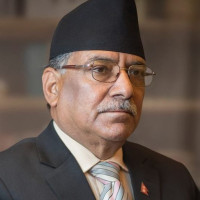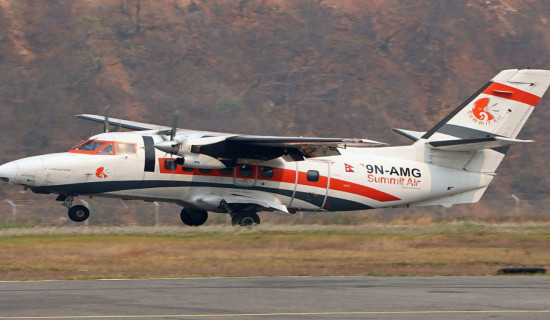- Monday, 19 May 2025
Kathmandu-Tarai Expressway
Uncertainty looms at starting Khokana point
By A Staff Reporter,Kathmandu, May 19: For over a decade, real estate developers around the southern rim of Kathmandu Valley have touted their properties as being close to the ambitious Kathmandu-Tarai/Madhes Expressway.
However, questions still persist about how long it will take for this transformative infrastructure to materialize -- especially due to unresolved land acquisition issues, particularly surrounding approximately 400 ropanis of land.
Conceived as a high-speed link connecting the Kathmandu Valley to the East-West Highway at Nijgadh in just one hour, the 13 segments of the expressway include a 7.6 km stretch expected to be completed within this fiscal. Other segments are either under construction or have only recently seen contract agreements signed.
Yet, a roughly 6-kilometre section from the Expressway's designated starting point remains mired in uncertainty due to unresolved land acquisition.
“This stretch—starting at Khokana, Lalitpur—has yet to undergo any tender process because land procurement has not been completed,” said Brigadier General Gaurav Kumar KC, Spokesperson for the Nepali Army, which has been tasked with overseeing the project.
Only 3 per cent of the total land required for the project remains to be acquired. Out of the 15,416 ropanis required, the government has not yet secured 377 ropanis that fall within the starting segment (zero kilo) in Khokana of Lalitpur.
Local opposition, particularly from residents of Khokana and Pharsidole, over land compensation and concerns regarding the demolition of culturally significant sites, has delayed progress in the region for over six years. Until all sections are fully completed, the dream of reaching the Tarai from Kathmandu in under an hour remains out of reach.
“Unless the Kathmandu end is connected to the Mahendra Highway, the road remains unusable,” said KC. “Completing just one segment doesn’t open the road for operation, but it does support overall momentum.”
Recently conducted site visits to Makwanpur and Bara districts reveal active construction, but in Kathmandu and Lalitpur, even the pilot track opened by the army over a decade ago is hard to trace in places.
The Expressway, running from Khokana across the Bagmati River and proceeding toward Makwanpur, becomes difficult to identify in satellite views on Google Maps until it entres Mahadevtar, Makwanpur—beyond the Bagmati boundary. There, the entry point to the Expressway’s longest tunnel is visible.
Among the 12 tunnels planned at six locations, the Mahadevtar-Dhedre tunnel is the longest at 3.4 kilometres. Each direction will have a dedicated tunnel to accommodate the one-way traffic flow of the planned four-lane Expressway, divided by a central three-metre median.
“We’re using the NATM (New Austrian Tunneling Method), which involves excavating first, removing the debris, and then installing a three-layer support system,” explained tunnel engineer Prakash Bhatta. Geotechnical expert Rupesh Shrestha from international consultant Yooshin Engineering assures that tunnels are structurally safest during earthquakes due to being surrounded by rock on all sides.
According to the Kathmandu-Tarai/Madhes Expressway Project Office, the project includes six tunnels spanning nearly 10.99 km and 89 bridges extending over 12.88 km in total.
The longest tunnel is 3.3 km at Mahadevtar, and the shortest is a 390-metre stretch at Sisautar. Four out of six tunnels already achieved breakthrough as of August, 2024.
Of the 89 bridges, 16 are of specialised engineering design, including some that are supported by columns as high as 83 metres. The Army is also constructing underpasses for vehicles, pedestrians, and wild animals.
Two-wheelers not allowed
Motorcycles and scooters will be prohibited on the Expressway. Apart from entry/exit points in Khokana and Nijgadh, there will be only one additional access point at Budune, Makwanpur. This will host an interchange, toll plaza, and service area with fuel, EV charging stations, restrooms, and food services, according to the project office.
Speed monitoring and tolling
Vehicles exceeding 50 km/h speed limit will be photographed and fined. Toll fees will be divided into three segments: Nijgadh to Hetauda, Nijgadh to Kathmandu, and Hetauda to Kathmandu. A full journey on the Expressway is projected to cost light vehicles around Rs. 900.
A delayed dream
Although the Army opened the initial track back in 2012, the preparation of a detailed project report (DPR) took significant time. In 2017, the government officially handed the project to the Nepali Army, which then contracted a South Korean firm to prepare the DPR.
Initially expected to be completed by fiscal year 2023/24, the project deadline has been extended to mid-April, 2027. As of now, physical progress stands at only 38.8 per cent, with financial progress at 40.24 per cent of as mid-March 2025. Some segments under active construction are reportedly 50 per cent complete.
Escalating costs
According to revised estimates from the Ministry of Physical Infrastructure and Transport and the Nepali Army, the project will cost Rs. 211 billion. The average cost per metre of road stands at a staggering Rs. 3 million.
Initial projections by the Asian Development Bank in 2008 estimated the cost at Rs. 70 billion. When the South Korean firm submitted the DPR in 2019, it projected an even lower cost. However, revisions after handing over the project to the Army raised the estimate to Rs. 175 billion, before settling at the current figure.
The delays have not only slowed progress but also pushed the costs higher. Still, the project is seen as vital to reducing fuel consumption, travel time, and transportation costs.
Nonetheless, given the sluggish pace of construction, doubts remain as to whether the project will be completed on time.
Since 2016, the project has already spent 73.66 billion as of eight months (mid-March, 2025) of the current fiscal (2024/25).
















